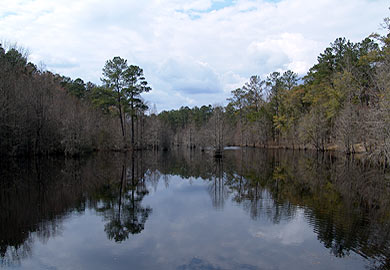DNR News
** Archived Article - please check for current information. **
August 25, 2015Aiken County wildlife area opens to the public Saturdays in September
Aiken County's Crackerneck Wildlife Management Area and Ecological Reserve will be open to the public on Saturdays during the month of September (5, 12, 19, and 26).
Crackerneck Wildlife Management Area and Ecological Reserve consists of 10,600 acres owned by the U.S. Department of Energy and managed for them by the S.C. Department of Natural Resources (DNR). The area is located in Aiken County, along the Savannah River and south of the town of Jackson, off SC 125. Access is through the check station gate off Brown Road.
Detailed maps/brochures of the area that include special rules and regulations can be requested in advance by e-mailing caudellm@dnr.sc.gov and providing a name and postal mailing address. Maps are also available at the check station where visitors sign in. The DNR office on the Savannah River Site can be reached at (803) 725-3663.
The area will be open for scouting, fishing and some other outdoor activities. All visitors must sign in before entering and sign out prior to leaving. No managed trails exist on the property. Bikes and horses are confined to the 50-mile road system and selected firebreaks. No weapons are allowed during this period. Daily hours are 6 a.m. to 8 p.m. Insect repellent is recommended for all users, and recreationists should bring their own water. One port-o-let is located at the check station.
Hunters are encouraged to utilize these open dates to scout the area prior to deer season. Habitat changes are continually occurring due to timber harvests, prescribed burns, weather events and road construction.
Fishing will be allowed during this period. Limited bank fishing opportunities exist at Skinface Pond so small boats are recommended. The bass limit at Skinface is two fish per person per day with a 14-inch minimum, while the catfish limit is five. Limits on bream are the same as state creel limits. A couple of swamp lakes are also accessible with small boats and will be open to fishing.
No bike trails exist at the present time. Mountain bikes are restricted to the 50-mile road system and selected firebreaks. Most roads are improved with crush-and-run, but offer relatively smooth riding.
Great opportunities exist for birders to view fall migrants and summer or permanent residents. Birding for terrestrial species is productive and easy due to the road system that traverses a variety of habitats. Wetland species occur, but are difficult to access and observe. DNR personnel at the gate can provide locations for species of interest.
No hiking trail exists at present, but the 50-mile road system goes through scenic areas and is a suitable substitute. In addition, hikers can utilize a 30-mile network of firebreaks that will get them off the beaten path. The more adventurous hikers can blaze their own trails just as hunters do. For anyone entering the Savannah River swamp, a compass and/or GPS Unit are strongly recommended.
Many people just enjoy touring the road system to see what can be observed, whether it be wildlife, wild flowers/butterflies, old home sites or cemeteries, forestry and wildlife management practices, etc. The entire 50-mile road system can be enjoyably ridden in under four hours. All roads, including jeep trails, are maintained in excellent condition.
Limited opportunities exist for canoeing in Skinface Pond or a few accessible swamp lakes that are picturesque. Alligators, snakes and a variety of water birds will be encountered. Access to Upper Three Runs Creek is prohibited for any reason.
Horses are limited to the 50-mile road system and selected firebreaks. While most roads are crush-and-run, they are well vegetated and horses seem to handle them well. Main roads have wide clearances so shoulders are an option. Firebreaks can be utilized when not planted for wildlife. Several places around Crackerneck are large enough to park several horse trailers.
Photographers have grand opportunities with wildlife, fall wildflowers/butterflies, scenic vistas, and forestry and wildlife management practices to name a few. However, photographers should have realistic expectations when trying to photograph wildlife. While abundant, wildlife at Crackerneck is truly wild and elusive. Stealth and patience are needed for success. Most animals are more active at dawn and dusk instead of mid-day.
More News
- DNR courtesy boating inspections set during Labor Day weekend
- DNR partners for increased monitoring of South Carolina flounder
- Import of deer, elk parts into SC still limited by state regulation
- Deer hunts for mobility impaired hunters to be held in Upstate; applications due Sept. 14
- Aiken County wildlife area opens to the public Saturdays in September
- 27th Annual Beach Sweep/River Sweep set for Sept. 19
- State antler records down slightly this year
- Liberty Hill Wildlife Management Area (WMA) opening this fall
- Sept. 14 is deadline for DNR's special youth deer hunts in Upstate
- Forty-five fields available for public dove hunting
- Boating safety public meetings to be held around the state
- DNR, U.S. Forest Service to provide special youth dove hunt in Union County
- Veterans encouraged to apply for Jackson deer hunt
- DNR unveils new Spanish language website
- S.C. Prescribed Fire Council annual meeting to be held in Walterboro Sept. 23-24
- Bat surveys taking place across South Carolina
- Two fishing lakes closed for renovation, restock
- Submit a winning "Trashter Piece" and take home an iPad Mini 3
- Freshwater fishing trends
- Saltwater fishing trends
- S.C. weekly tidetable
- DNR video
- Archived news releases
